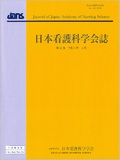Japanese
English
- 販売していません
- Abstract 文献概要
- 参考文献 Reference
要旨
目的:ストレッチャー移送時に看護師が患者に馬乗りになって行う胸骨圧迫(Straddling Chest Compression:S-CC),一般的な胸骨圧迫(Basic Chest Compression:B-CC),歩行しながら行う胸骨圧迫(Walking Chest Compression:W-CC)の3つの姿勢の質を比較し,女性看護師が行う有効な胸骨圧迫姿勢を明らかにする.
方法:臨床経験5年以上の女性看護師18名を対象とし,姿勢による胸骨圧迫の質(圧迫深度,圧迫テンポ,リコイル)を測定した.
結果:S-CCとB-CCは,W-CCと比較して圧迫深度が有意に深かった(p<.001).また胸骨圧迫の質と実施者の体格との関連を検討し,S-CCでは有意な相関はなかった.
結論:ストレッチャー移送時に女性看護師が行う胸骨圧迫の姿勢として,W-CCよりもS-CCが有効である可能性が示唆された.
Purpose: To elucidate the most effective posture for female nurses to administer external chest compression to patients during transportation on a stretcher by comparing the quality of pressure on the chest.
Method: Using a human body model, 18 female nurses with more than five years of clinical experience administered external chest compression using three different styles: straddling chest compression (S-CC), in which a nurse assumes a position immediately over the patient; basic chest compression (B-CC), in which a nurse kneels on the floor beside a patient; and walking chest compression (W-CC), in which a nurse walks alongside a patient to administer external cardiac massage. The depth, rate and recoil of the compression were measured using a measurement application to evaluate the quality of the cardiac massage.
Results: Multiple comparisons revealed that S-CC and B-CC had a significantly higher compression depth than W-CC (p < .001). No significant differences were observed in terms of compression and recoil rates among the three styles. An analysis of the correlation between the quality of compression and the physique of the administrator showed no significant correlation when S-CC was used.
Conclusion: There is a possibility that S-CC is more effective than W-CC in terms of posture if a female nurse is to administer external chest compression while a patient is being transported on a stretcher.
Copyright © 2021, Japan Academy of Nursing Science. All rights reserved.


